A Gamma-Ray Burst (BATSE trigger number 6891) was detected on 1998 July 3,
04:24:35 UT with a peak count rate of 3750 cts/s. It was in the field of
view of the RXTE-ASM and the position could be determined to +/- 4 arcmin.
A BeppoSAX NFI observation of the ASM error box revealed a fading X-ray source
at
- GCN notice #123
James Rhoads, Ron Downes, and Jennifer Christensen report on behalf
of the Kitt Peak Gamma Ray Burst followup team:
Ron Downes and Jennifer Christensen observed the error box of GRB
980703 in R band with the Kitt Peak National Observatory 0.9m
telescope. Total integration time was 1 hour, beginning at
980704 09:51 UT. The field of view is 23 arcminutes, and so includes
the entire RXTE and BeppoSAX error boxes for the gamma ray burst.
The seeing was poor but the weather was otherwise good.
We compared our images with the digitized POSS II image of the field.
Our image is considerably deeper than the POSS II, and so contained
many objects not visible there. However, none of these was clearly
brighter than the POSS II limiting magnitude, which we can therefore
take as the upper limit for any GRB afterglow in this field
(approximately R ~ 20, based on flux measurements in our image for
marginal detections on the POSS II).
One moving source with R ~ 19.5 was detected, presumably a main belt
asteroid (the ecliptic latitude of the field is about 7 degrees),
which was travelling towards the east northeast at (very roughly) 27
arcseconds per hour. We estimate that this object was in the RXTE
error box from about 0400 to 1600 UT, near the center of the RXTE
error box around 1000 UT, and near the center of the BeppoSAX error
circle (cf. BeppoSAX GRB Mail n. 98/22) around 1600 UT on 980704.
Based on the RMS noise in our image and a rough photometric
calibration from standard stars in the Mark A field, we estimate
a 4 sigma limiting magnitude in a 4" diameter aperture between
R=23.0 and R=23.2.
We will provide further details and a link to our final image at
http://www.noao.edu/noao/grb/980703.html .
You are welcome to use this data as a comparison epoch in counterpart
searches. We request that we (Ron Downes, Jennifer Christensen, and
James Rhoads) be included as authors on any afterglow detection or
upper limit that you arrived at using this image.
- GCN/RXTE_ASM_GRB_POSITION Alert
GRB_RXTE_RA: 359.768d {+23h 59m 04s} (J2000),
359.749d {+23h 58m 60s} (current),
359.128d {+23h 56m 31s} (1950)
GRB_RXTE_DEC: +8.556d {+08d 33' 21"} (J2000),
+8.548d {+08d 32' 51"} (current),
+8.278d {+08d 16' 39"} (1950)
GRB_ERROR_RA1: 359.873d {+23h 59m 30s} (J2000)
GRB_ERROR_DEC1: 8.653d {+08d 39' 11"} (J2000)
GRB_ERROR_RA2: 359.742d {+23h 58m 58s} (J2000)
GRB_ERROR_DEC2: 8.573d {+08d 34' 23"} (J2000)
GRB_ERROR_RA3: 359.664d {+23h 58m 39s} (J2000)
GRB_ERROR_DEC3: 8.459d {+08d 27' 32"} (J2000)
GRB_ERROR_RA4: 359.795d {+23h 59m 11s} (J2000)
GRB_ERROR_DEC4: 8.540d {+08d 32' 24"} (J2000)
GRB_RXTE_ERROR: 0.142 [deg radius (stat+sys), 90%]
GRB_RXTE_INTEN: 1400.00 [mCrab]
COMMENTS: RXTE-ASM GRB Coordinates.
COMMENTS: Please note this is a new position: a long
COMMENTS: diamond (17' x 3.6' at a position angle of
COMMENTS: 46.77 degrees), rather than a square box.
COMMENTS:
COMMENTS: The quoted intensity has a 1-sigma error
COMMENTS: of 400 mCrab (2-12 keV). Please note that
COMMENTS: the last message had incorrect units.
- GCN notice #125
K. Hurley, on behalf of the Ulysses GRB team, and C. Kouveliotou,
on behalf of the BATSE team, report: We have triangulated the position
of GRB980703 (BATSE 6891). The preliminary annulus is centered at
(J2000) R.A.=331.648 degrees, Decl.=-9.065 degrees; its radius is 33.200
+/- 0.156 degrees. The position of the SAX NFI fading X-ray source
(BeppoSAX GRB MAIL N. 98/23) is consistent with this annulus. A map may
be found at
http://ssl.berkeley.edu/ipn3/980703 (and reproduced below).
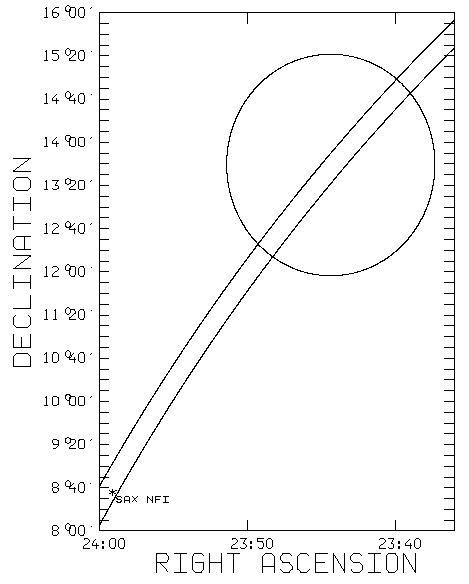
- GCN notice #126
D. A. Smith, A. M. Levine, and M. Muno on behalf of the RXTE/ASM teams
at MIT and NASA/GSFC, report:
"The ASM detected emission from GRB 970803 (BATSE trigger #6891) in
the crossed fields of view of two of its cameras. Each camera
confined the position to a long, thin box at 90% confidence (including
systematic & statistical error). The intersection of these error
boxes yielded a diamond shaped region with corners at (R.A., Decl.;
J2000): (359.873d, +8.653d), (359.742d, +8.573d), (359.664d, +8.459d),
and (359.795d, +8.540d). This analysis refines and supercedes the
circle of radius 4' reported in IAUC 6966.
The burst showed a slow (~40 s) rise to a peak of 1.4+-0.4 Crab (2-12
keV). The intensity began to rise 18 s before the BATSE trigger time
of 04:22:45 UTC. At 04:23:07 UTC, the ASM rotated such that the burst
moved to the edge of one camera's FOV, and out of the FOV of the
second camera. This rotation lasted six seconds. Binning the GRB
flux during the second 90-s observation into 9-s bins shows a roughly
linear decrease from ~750 mCrab at a rate of ~7 mCrab/s."
- GCN notice #127
T.J. Galama (U. of Amsterdam), J. van Paradijs (U. of Amsterdam and
U. of Alabama in Huntsville), L.A. Antonelli (Astronomical Observatory
of Rome and SAX-SDC, Rome), P. Vreeswijk (U. of Amsterdam),
C. Kouveliotou (USRA/MSFC), V. Torroni (SAX-SOC Rome), and C. Pastor
(Dataspazio, Rome), on behalf of a larger collaboration, report:
"We have observed the RXTE/ASM error box of GRB980703 with the
BeppoSAX Narrow Field Instruments (NFI) starting about 22 hr after the
burst in the period July 4.096-5.084 UT. Preliminary analysis of the
data shows a previously unknown X-ray source 1SAX J2359.1+0835 in the
LECS and MECS at RA = 23h59m07s, Dec = +08d35'33" (equinox 2000.0),
with an error radius of 50" (inside the refined RXTE/ASM error box;
GCN/RXTE_ASM note July 6 1998). In the first 8200 sec of the
observation the average count rate was (1.14 +- 0.16)x10^-2 cts/s in
the combined data of MECS 2 and 3, corresponding to a flux of 7.5 x
10^-13 ergs cm^-2 s^-1. In the last 30000 sec the average count rate
was reduced to (7.3 +- 0.7)x10^-3 cts/s corresponding to a flux of 4.8
x 10^-13 ergs cm^-2 s^-1. In addition the field contains the sources
1SAX J2359.9+0834 at RA = 23h59m59s, Dec= +08d34'03" and 1SAX
J0000.1+0817 at RA = 00h00m04s Dec=+08d17'14". Both these sources are
outside the RXTE/ASM error box, do not show any significant
variability and are coincident with ROSAT sources, 1RXS
J235959.1+083355 and 1RXS J000007.0+081653, respectively. A new
follow-up observation will be performed with the BeppoSAX NFI."
- GCN notice #128
D. A. Frail, (NRAO), J. P. Halpern (Columbia), J. S. Bloom (CIT),
S. R. Kulkarni (CIT), S. G. Djorgovski and the BeppoSAX GRB Team
report:
We observed the entire RXTE error circle of GRB 980703 (IAU Circ.
6966, GCN #126) with the VLA on 1998 July 4.4 UT at a wavelength of 6
cm. A single, weak radio source is detected coincident within the 50
arcsec radius error circle of a fading X-ray source seen by BeppoSAX
(GCN #127). The 6-cm flux density is 135 microJy and the rms noise is
26 microJy/beam, with a 1.6 arcsec beam. The approximate position of
this source is 23h59m6.67s, +08d35'6.7" (equinox J2000). Further radio
observations are planned and to test for any variability.
Keck II images obtained by J. B. Oke (DAO) and K. D. Horne (U. St
Andrews) on 1998 July 6.60 UT in B and R with 0.5 arcsecond seeing
reveals a point-like object at position RA = 23:59:06.69, Decl =
+08:35:07.26 (J2000, uncertainty 0.4"), consistent with the position
of the radio source. Comparison with images obtained at the Palomar
60in by R. O. Marzke (Carnegie) and D. R. Patton (U. Victoria) on July
4.48 UT show the object to have faded by 0.7 mag in R based on
differential photometry with respect to nearby stars. An approximate
photometric calibration can be made assuming that a nearby star at RA
= 23:59:05.94, Decl = +08:34:57.4 has R = 16.5 as listed in the USNO
A1.0 catalog. In this system, the optical transient faded from R =
21.2 on July 4.48 to R = 21.9 on July 6.60. This suggests a power-law
decay constant of 0.75 between these dates. A finding chart can be
found at
http://astro.caltech.edu/~jsb/grb980703_find.ps"
- GCN notice #130
M.R. Zapatero Osorio (Instituto de Astrofisica de Canarias, IAC,
E-38200 La Laguna, Tenerife, Spain)
A. Castro-Tirado (Laboratorio de Astrofisica Espacial y Fisica
Fundamental, LAEFF-INTA, Madrid)
J. Gorosabel (LAEFF)
A. Oscoz, S. Kemp (IAC)
F. Frontera, L. Nicastro (on behalf of the BeppoSAX team) report
Images in the R-band have been obtained at the 0.8-m IAC80 telescope
(Teide Observatory) on July 4 and 6 including the BeppoSAX error box
for the X-ray source 1SAX J235907+0835 presumably related to GRB980703
which was detected by both BATSE and RXTE. These data reveal an object
located at RA = 23h 59m 6.7s DEC = 8d 35' 7'' (+/- 2'', Eq. J2000)
which has faded by about 1.5 mag at this wavelength. A preliminary
photometric analysis allows us to determine R = 20.6 +/- 0.1
(July 4.123 UT) and 22.1 +/- 0.2 (July 6.137 UT). No other objects
varying by more than 0.2 mag are seen down to a limiting magnitude of
R = 22.5. A finder chart is available via anonymous ftp to
ftp.ll.iac.es (cd publong/grb980703/) and reproduced below.
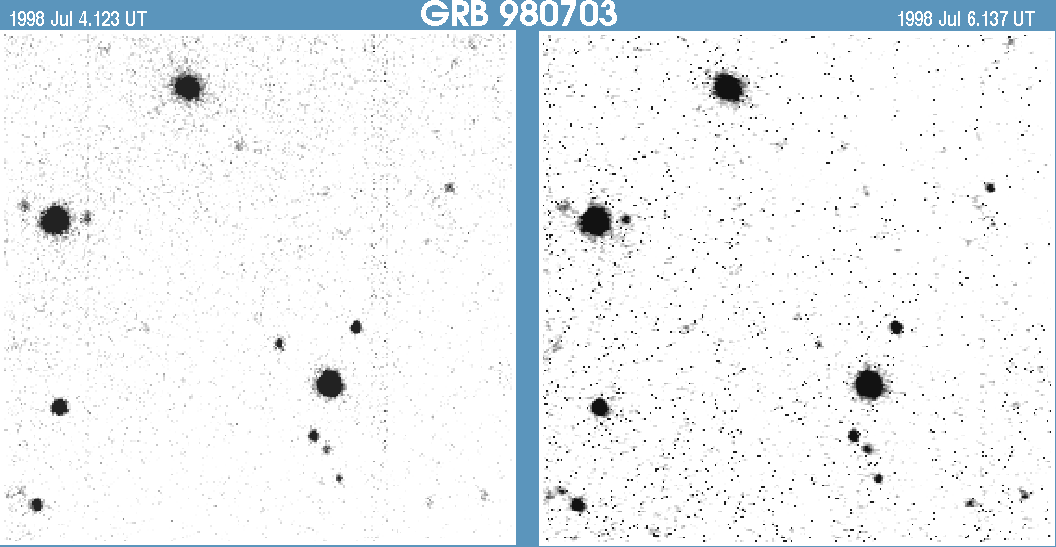
- GCN notice #131
The U. S. Naval Observatory GRB team (A. A. Henden, F. J. Vrba,
C. B. Luginbuhl, H. H. Guetter, B. Canzian, S. E. Levine, J. A. Munn),
D. H. Hartmann (Clemson Univ.), and M. C. Jennings (IGPP, UCR visitor)
report the H-band detection of the GRB 980703 optical candidate
proposed by Frail, et. al. (GCN #128). Observations were obtained with
the USNO Flagstaff Station 1.55-m telescope and IRCAM (Rockwell/NICMOS HgCdTe)
camera on UT 1998 July 4.458 under photometric conditions. The
H-band object was at RA 23:59:06.70, DEC +08:35:07.1 (J2000), consistent
with the position by Frail, et. al. Based on a nearby standard, we measure
the source to have H = 17.55 +/ 0.20. Using Frail, et. al.'s rough
calibration of R = 20.2 for their July 4.48 observation of the optical
candidate, implies R-H = 3.6 +/- 0.3 if the USNO-A photometric error is
about +/- 0.2 mag.
For further information contact Arne A. Henden at aah@nofs.navy.mil or by
telephone at (520) 779-5132.
- GCN notice #132
P.M. Vreeswijk, T.J. Galama, (U. of Amsterdam); Y. Lipkin,
E. Leibowitz (Wise Observatory, Tel Aviv University, Israel);
C. Lidman, V. Doublier (ESO, Chile); J. van Paradijs (U. of Amsterdam
and U. of Alabama in Huntsville); C. Kouveliotou, C. Robinson
(NASA-MSFC/USRA) on behalf of a larger collaboration, report: "We
obtained I band images with the ESO NTT and the Wise Observatory 1-m
telescope that cover the RXTE error circle of GRB980703 (IAU
Circ. 6966, GCN #126). We find the following magnitudes for the
optical transient proposed by Frail et al. (GCN #128; see also GCN
#130 and GCN #131):
UT date I telescope
July 4.06 20.1 +/- 0.2 Wise 1-m
July 4.37 20.6 +/- 0.2 NTT
July 5.05 20.9 +/- 0.3 Wise 1-m
July 6.44 21.3 +/- 0.2 NTT
No other sources in the entire RXTE error circle are found to be
variable by more than 0.4 magnitude between the two NTT epochs down
to I=22.6.
- GCN notice #133
C. Bartolini, S. Bernabei, A. Guarnieri, N. Masetti, A. Piccioni and G.
Valentini, University of Bologna, F. Frontera (on behalf of the BeppoSAX Team)
communicate: "A preliminary analysis of two 30 min CCD frames of the error box
of GRB 980703 in R band obtained with the 1.5-m telescope of the Bologna
University and the Bologna Astronomical Observatory on 1998 July 5.06 and 6.06
UT shows no variable object within 0.3 mag. The seeing was 2".7 on July 5,
2".3 on July 6; the measurable limiting magnitude was R ~ 21 in both nights.
However, in the position indicated in GCN 128 and GCN 130 a faint object is
barely visible."
- GCN notice #135
H. S. Park(LLNL), R. A. Porrata(LLNL), and G. G. Williams (Clemson Univ.)
report on behalf of the LOTIS collaboration:
R. Bionta, E. Ables, L. Ott, E. Parker (LLNL)
S. Barthelmy, N. Gehrels, T. Cline (NASA/GSFC)
D. Hartmann (Clemson Univ.)
C. Kouveliotou, G. Fishman, C. Meegan (NASA/MSFC)
D. Band (U.C. San Diego)
K. Hurley (U. C. Berkeley)
D. Ferguson (Cal State, Hayward)
R. Nemiroff (Michigan Technological University)
LOTIS obtained images in the field of GRB980703 within 5.03 hours after
the burst began (July 3.39 UT). LOTIS resumed its automatic observation
program after a recent upgrade incorporating thermoelectric cooling to its
four CCD cameras. The upgrade increased the sensitivity from the
non-cooled apparatus by at least three magnitudes.
LOTIS is capable of responding to GRB events as soon as 10 s after a burst
localization by utilizing the BATSE real-time trigger to initiate the fast
slewing mount. The telescope has a 17.4 x 17.4 degree wide field-of-view
which can cover a large portion of the BATSE error box for real-time triggers.
The GRB980703 trigger came at 9:20 PM local time while there was still day
light in California. In addition, the reported OT location (GCN #128) was
below the horizon when the sky monitoring began that night. Therefore, LOTIS
could not cover this event in real-time. However, our all-sky patrol program
eventually imaged the GRB980703 field 5 hours after the burst. We also have
the sky patrol data from the previous and the following nights. The
integration time used for these images was 30 s. We have analyzed the images
taken at July 2.39, 2.47, 3.39, 3.47, 4.39, 4.47 and 6.47 UT by comparing
them to each other and with the Digital Sky Survey images.
No flaring or fading sources were observed at mV~15 with a 5 sigma
detection threshold. The LOTIS images of this event can be viewed at
http://hubcap.clemson.edu/~ggwilli/LOTIS/GRB980703.html.
- GCN notice #136
J. S. Bloom, S. J. Djorgovski, S. R. Kulkarni (CIT) and D. A. Frail (NRAO)
report on behalf of the Caltech-NRAO GRB collaboration: "In the GRB 980703
field (IAUC #6966; GCN #126; GCN #127) of the radio/optical transient
discovered by Frail et al. (GCN #128), R-band images (10 min) were
obtained at the Palomar 60 inch on July 4,5 by R. O. Marzke (Carnegie) and
D. R. Patton (U. Victoria) and at the Keck-II 10-m on LRIS by J. B. Oke
(DAO), K. D. Horne (U. St Andrews), and R. Gomer. Photometry, based on
an approximate LRIS zero-point (which is uncertain to ~0.2 mag), results
in the following derived magnitudes for the transient:
Date (UT) Intr Mag OT Rc
-----------------------------------
Jul 4.477 P60 21.3 +/- 0.2
Jul 5.482 P60 21.8 +/- 0.3
Jul 6.607 LRIS 22.03 +/- 0.02 (+ zero point uncertainty 0.2mag
for all three points)
The zero-point may change with expected calibrations but the slope will
not. The fading a power-law decline of -0.74, consistent with the I-band
fading (-0.84) found from data in Vreeswijk et al. (GCN 132), would make
this OT the slowest fading counterpart to a GRB yet. However, since the
decay appears somewhat stronger at earlier epochs, we believe that the
light may be contaminated by an underlying host. If true, the light curve
should show even more flattening. This hypothesis appears corroborated by
the fact that the spectral indices derived from the I/R/H-band data are
not consistent with a simple fireball model prediction from the decay
constant. A summary light curve with all reported I/R-band data may be
found at
http://astro.caltech.edu/~jsb/grb980703_ltcurve.ps" (see below).
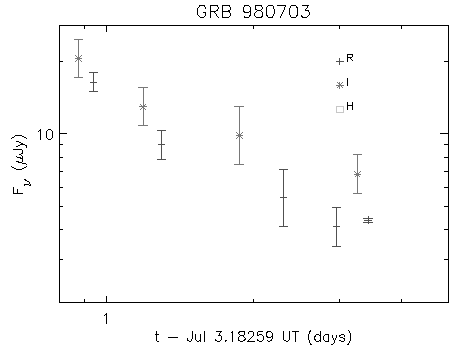
- GCN notice #137
S. G. Djorgovski, S. R. Kulkarni (Caltech), R. Goodrich (WMKO),
D. A. Frail (NRAO), and J. S. Bloom (Caltech), report on behalf
of the Caltech GRB collaboration:
Spectra of the proposed optical/radio counterpart of GRB 980703 (see GCN
Circ. 128) were obtained by R. Goodrich at the Keck-II telescope on July
7.6 UT. The object has a very blue continuum, one strong emission line
at approximately 7330 A, and several absorption features in the blue
part of the spectrum. If the emission line is identified as [O II] 3727,
then the redshift is 0.967. The line cannot be Ly alpha, since there is
no sign of intergalactic absorption blueward of it. No broad emission
lines are seen at this stage of reductions; the spectrum is thus unlike
that of a quasar or a BL Lac, and it is consistent with a young, compact,
unobscured starburst. (We note however that the object is unresolved
in our images obtained in half-arcsec seeing.)
- GCN notice #139
S. G. Djorgovski, S. R. Kulkarni (Caltech), R. Goodrich (WMKO),
D. A. Frail (NRAO), and J. S. Bloom (Caltech), report on behalf
of the Caltech GRB collaboration:
Analysis of the spectra of the proposed optical/radio counterpart of
GRB 980703 (see GCN Circ. 128, 136, 137) gives the following results:
The strong emission line is definitively identified as [O II] 3727 at
the redshift z_em = 0.9660 +- 0.0002. It has the equivalent width of
90 +- 2 Angstroms (observed), or 45.7 +- 1 A in the restframe. This
is somewhit higher than typical for galaxies at comparable redshifts
and magnitudes. After correcting for the as-yet unknown contribution
of the GRB afterglow to the continuum flux, these numbers will be higher.
The observed line flux is 2.7e-16 erg/cm2/s.
There are several absorption features identified as Fe II (2344, 2374,
2383, 2587, and 2600 A) and Mg II (2796 and 2803) lines, with the mean
redshift z_abs = 0.9653 +- 0.0007, superposed on an otherwise featureless
UV continuum. This too is typical of actively star-forming galaxies at
similar redshifts. We also see the 4000-Angstrom break.
The observed spectrophotometric magnitude at the epoch of these
observations (July 7.6 UT) are: B = 23.3, V = 22.65, and R = 21.9 mag,
with the zero-point uncertain by a few tenths of a magnitude, due to the
unknown slit losses. The UV continuum blueward of the [O II] line can
be described with a power-law F_nu ~ nu**alpha, with alpha = -1.5 +- 0.2,
possibly indicative of a modest extinction.
Assuming a Friedmann cosmology with H_0 = 65 km/s/Mpc, Omega_0 = 0.2, and
Lambda_0 = 0, the luminosity distance at this redshift is 1.9208e28 cm.
Our observed [O II] line flux then translates to the restframe line
luminosity of 1.25e42 erg/s. Assuming the conversion from Kennicutt
(1992), the implied star formation rate is about 63 M_sun/yr, even
without any extinction or slit-loss corrections.
We thus conclude that the host galaxy of GRB 980703 is a compact starburst
object. This gives some support to the models which associate origins of
GRBs with massive star formation.
- GCN notice #140
The U. S. Naval Observatory GRB team (A. A. Henden, F. J. Vrba,
C. B. Luginbuhl, H. H. Guetter, B. Canzian, S. E. Levine, J. A. Munn),
D. H. Hartmann (Clemson Univ.), and M. C. Jennings (IGPP, UCR visitor)
report:
Observations were obtained with the USNO Flagstaff Station 1.55-m telescope
and IRCAM (Rockwell/NICMOS HgCdTe) camera centered on UT 1998 July 8.459.
A total integration time of 40 minutes was achieved, with a limiting magnitude
of approximately H = 19.4. No object was detected at the proposed optical
transient position reported by Frail, et. al. (GCN #128).
- GCN notice #141
D. A. Frail, (NRAO), S. R. Kulkarni (CIT), J. S. Bloom (CIT), S. G.
Djorgovski and the BeppoSAX GRB Team report:
The radio source identified as a possible afterglow in GCN #128 has
brightened considerably and is exhibiting short-timescale
variability. During a 3.5 hour VLA run on 1998 July 7 the flux density
at 4.86 GHz varied from 1.1 mJy to 0.75 mJy. Variations are also
present at 8.46 GHz but they are smaller than those at 4.86 GHz.
Similar fluctuations have been seen at early times toward previous
radio afterglows and were attributed to interstellar scintillation.
Start Date 1.43GHz flux 4.86GHz flux 8.46GHz flux
(microJy) (microJy) (microJy)
---------------------------------------------------------
Jul. 4.4 UT -- 137 --
Jul. 7.3 UT -- 910 890
Jul. 8.5 UT 120 635 965
---------------------------------------------------------
On 1998 July 8 the spectrum rises with higher frequencies. Such
behavior is uncommon in most extragalactic radio sources but it has
been seen in the early spectra of previous radio afterglows and
attributed to synchrotron self absorption.
The radio source appears unpolarized, with a 3-sigma limit on linear
polarization at 4.8 GHz and 8.46 GHz of ~8%. An improved position is
R.A.=23h59m6.666s, Dec.=+08d35'7.07" (equinox J2000). The position
error is approximately +/-0.05".
The strong [OII] line emission seen toward GRB980703 (GCN#139) raises
the possibility of detecting the host galaxy from radio radiation
produced by ongoing star formation (Condon An.Rev.A&A, 30, 575,
1992). For the assumed distance and star formation rate given in
GCN#139 we estimate that the host galaxy will be 105, 40 and 25
microJy at 1.43, 4.86 and 8.46 GHz, respectively. Thus the measurement
at 1.43 GHz could contain a significant contribution from the host galaxy.
We note that a redshift of z=0.966 (GCN #137) along with the average
fluxes reported by Galama et al. (GCN #127) implies a lower limit to
the X-ray afterglow isotropic energy release of 9.5e49 ergs over the
course of the 10.6 hour BeppoSAX NFI pointing. Consistent with this
(though it is difficult to translate BATSE count rates to flux and
fluence) the total fluence of the GRB is likely ~0.5 -- 1 x 10^-5
erg/cm^2 implying a total isotropic energy release of ~2 -- 5 x 10^52
erg; this falls between the implied energies of GRB 970508 (Metzger et
al. Nature 387, 878) and GRB 981214 (Kulkarni et al. Nature, 293, 35).
- GCN notice #142
H.Pedersen, Copenhagen University Observatory,
H.Korhonen, Nordic Optical Telescope, La Palma,
A.O.Jaunsen, Institute for Theoretical Astrophysics, Oslo,
I.Ilyin & R.Duemmler, University of Oulu, and
F.Frontera, Inst.TeSTRE, Bologna (on behalf of the BeppoSAX team), report:
On July 4, 5, 6, and 7 we obtained R band images (600 sec each, seeing
0.75"-1.0" FWHM) of the GRB980703-field using the 2.56-m Nordic Optical
Telescope. The field-of-view was 3' x 3' and all images were acquired under
good photometric conditions.
Images taken during the first three nights were centered on the position
initially reported from RXTE by Levine et al. (IAUC 6966) and missed the
radio- and optical transient (Frail et al., GCN #128) by ~8 arcsec.
Intercomparing these images we found one variable star. Its position is
R.A. 23:59:03.7, Dec. +08:33:51.3 (J2000). An approximate R-band zero-point
is determined from the USNO catalogue entry U0975_21757527 (a star 15" SW
of the OT), which has R=16.5. This gives the following photometry for the
new variable:
UT Var
1998 July 04.101 R= 21.0 +/- 0.2
04.149 R= 21.1 +/- 0.2
04.194 R= 21.6 +/- 0.2
05.086 R= 21.5 +/- 0.2
05.146 R= 21.2 +/- 0.2
05.195 R= 21.1 +/- 0.2
06.188 R= 21.1 +/- 0.2
An image centered on the RT/OT was taken on July 7. For the OT we find the
following R-band magnitude (using the already mentioned standard star):
1998 July 07.163 R= 22.45 +/- 0.2
The errors reflect a conservative estimate of the uncertainty in the
determination of the zero-point.
Our result is consistent with a power-law decline as reported by Bloom et al.
(GCN #136) when comparing to other reported R-band values.
Further information can be found on
http://vega.uio.no/~ajaunsen/grb980703
- GCN notice #143
GRB 980703 was detected by BATSE on July 3.182468 UT as trigger number
6891. The event consisted of two pulses, each lasting approximately
100 s, with a total duration of about 400 s. The first pulse had
significant sub-structure, whereas the second, weaker, episode was
relatively smooth. The burst's peak flux (50-300 keV; integrated over
1 s) and fluence (>20 keV) are 2.42 (-/+ 0.06) photons cmE-2 sE-1 and
4.59 (-/+ 0.42) x 10E-5 erg cmE-2, respectively---ranking it in the
top 20% (5%) of the BATSE burst flux (fluence) distribution. The
average spectral hardness of the burst, as estimated by the ratio of
100-300 keV counts to those in the 50-100 keV range, is H32 = 1.05
(-/+ 0.02), which is average for events of this long duration. The
BATSE burst location is consistent with those measured by RXTE-ASM
(GCN/XTE Notices) and BeppoSAX (GCN #127). A location sky-map and
lightcurve for this event (and other notable bursts) are available at
the BATSE Rapid Burst Response world-wide-web site:
http://www.batse.msfc.nasa.gov/~kippen/batserbr/
- GCN notice #144
James Rhoads, Ron Downes, and Jennifer Christensen report on behalf
of the Kitt Peak Gamma Ray Burst followup team:
Using images we obtained on July 4.433 (see GCN Circ. 123), we have
measured the R band magnitude of the proposed optical counterpart to
GRB 980703 (GCN Circ. 128, 130).
We have also measured R band magnitudes of local comparison stars to
facilitate photometric calibration of other data. We converted
instrumental to standard magnitudes using observations of Landolt
standard stars in the fields SA 109 and Mark A. We fitted for the
zero point and color term of the photometric transformation. Our
standard star fields and the first GRB frame were all taken at
essentially the same airmass, so we did not fit for an airmass
correction term. All magnitudes for standard stars were measured in
14 arcsecond diameter apertures, to match the procedure of Landolt
(1992 AJ 104, 340). Magnitudes for objects in the GRB frame were
measured in several apertures and corrected to the equivalent 14
arcsecond aperture magnitude using a curve of growth derived from
stars near the GRB. The GRB measurements themselves were based on
2.7 to 4.1 arcsecond diameter apertures.
Our results, based on our combined final image (60 minutes integration
with the KPNO 0.9m telescope), are summarized below:
ID x y d(RA) d(Dec) R dR
(1998 July 04.433 UT)
OT 896.4 1051.6 0.0 0.0 21.287 0.083
V 1004.6 1119.4 -46.1 -73.6 21.185 0.079
1 891.5 1248.5 -133.9 3.4 18.815 0.015
2 837.5 1195.1 -97.6 40.1 20.132 0.035
3 939.3 1157.7 -72.2 -29.2 19.807 0.026
4 889.9 1077.4 -17.6 4.4 20.392 0.040
5 909.6 1068.6 -11.6 -9.0 16.642 0.015
6 927.0 1064.1 -8.5 -20.8 20.717 0.049
7 887.4 1043.7 5.3 6.1 22.662 0.219
8 919.9 977.6 50.3 -16.0 19.109 0.017
9 857.0 974.5 52.4 26.8 16.492 0.010
10 248.5 1246.8 -132.8 440.5 15.842 0.016
11 748.8 1718.7 -453.7 100.3 16.045 0.004
12 395.5 1731.0 -462.0 340.6 18.174 0.021
13 375.8 1728.4 -460.3 354.0 17.824 0.024
14 1633.4 1604.2 -375.8 -501.1 17.069 0.006
15 1683.8 941.1 75.1 -535.5 17.175 0.005
16 1691.3 1273.4 -150.9 -540.5 16.843 0.012
17 1565.7 1440.8 -264.7 -455.1 15.617 0.005
18 1500.5 1245.5 -131.9 -410.8 17.774 0.015
19 1495.4 448.3 410.2 -407.3 15.787 0.009
20 504.0 529.4 355.0 266.8 15.579 0.010
(x,y) are coordinates in our image. d(RA) and d(Dec) are approximate
offsets in arcseconds from the location of the transient, uncorrected
for field rotation. R and dR are the measured R band magnitude and
the statistical uncertainty in that magnitude (determined using the
IRAF tasks "phot" and "mkapfile"). The uncertainty in the photometric
zero point is an additional 0.010 magnitudes. The color term was
(-0.001 +- 0.018)(V-R) and so will add a small additional uncertainty
( < 0.02 mag for objects of normal color) to the R band magnitudes since
we have no color information for most objects in the field.
The ID entries are mostly arbitrary numbers. "OT" refers to the
optical transient. "V" refers to the variable star reported by
Pedersen et al (GCN Circ. 142).
None of the objects tabulated above shows photometric variations
substantially above 1 sigma random errors in a comparison of our three
exposures (each 20 minutes long, beginning on 980704 UT 09:51:16,
10:13:40, and 10:35:40). Individual magnitude measurements for the
optical transient and for Pedersen et al's variable are as follows:
UT R(OT) dR(OT) R(V) dR(V)
1998 July 04.418 21.168 0.118 21.010 0.098
1998 July 04.433 21.353 0.114 21.114 0.093
1998 July 04.448 21.218 0.101 21.170 0.099
(Here "UT" is the UT of mid-exposure.)
Our star number 5 is the USNO catalog entry used by Frail et al (GCN
Circ 128) to calibrate their optical photometry. Applying a
correction of +0.142 magnitudes to their photometry based on our
calibration implies magnitudes for the transient of 21.34 on July 4.48
and 22.04 on July 6.60. This agrees with the zero point of Bloom et
al (GCN Circ 135) to much better than their reported accuracy of 0.2
mag. Comparing our measurement to the July 4.458 H band magnitude
from Henden et al, we find R-H = 3.75 +- 0.22 . Comparing to the July
4.37 I band measurement of Vreeswijk et al (GCN Circ 132) yields R-I =
0.64 +- 0.22 . In both cases we have corrected the colors for
differences between the observation epochs by assuming an achromatic
t^(-0.75) decay of the flux.
- GCN notice #145
T.J. Galama, P.M. Vreeswijk (U. of Amsterdam), J. van Paradijs
(U. of Amsterdam and U. of Alabama in Huntsville), C. Kouveliotou
(USRA/MSFC), L.A. Antonelli (Astronomical Observatory of Rome and
SAX-SDC, Rome), V. Torroni (SAX-SOC Rome), and C. Pastor (Dataspazio,
Rome), on behalf of a larger collaboration, report:
"We have analyzed a second BeppoSAX NFI observation of the RXTE/ASM
error box (Smith et al. GCN #126) of GRB 980703 made July 7.779-8.706
UT. Preliminary analysis of the combined MECS 2 and 3 data shows that
the variable X-ray source 1SAX J2359.1+0835 (Galama et al. GCN #127),
positionally coincident with the radio counterpart (Frail et al. GCN
#128) decayed by a factor 5.5 +- 1.5 between July 4 and 8. Assuming a
power law light curve we find a decay index of 1.33 +- 0.25"
- GCN notice #146
L. Amati, F. Frontera (ITeSRE-CNR, Bologna), E. Costa, M. Feroci,
(IAS-CNR, Rome) report:
GRB980703 (BATSE trigger 6891) also triggered the BeppoSAX/GRBM units 1
and 4 on July 3 at 04:22:55.3 UT. On the basis of the RXTE/ASM
position of the GRB (BACODINE 6891), the GRB incoming direction on the
GRBM units is at large angles, 62 degrees and 105 degrees, from units 4
and 1 axis, respectively. The event is visible for 90 s in both units and
presents a double peak morphology.
The 1 sec peak flux in the 40 - 700 keV energy range is 208 +/- 43
counts/s in unit 1 and 189 +/- 41 counts/s in unit 4. The estimated photon
peak flux is 4.7 +/- 0.9 photons cmE-2 sE-1 corresponding to
(2.1 +/- 0.4) x 10E-6 erg cmE-2 sE-1. The fluence in the same energy band is
(3 +/- 1) x 10E-5 erg cmE-2.
- GCN notice #147
V. Sokolov (SAO RAS), S. Zharikov (SAO RAS), I. Panthenko (SAI)
and the SAX GRB team report:
On 1998 July 25.01 UT we obtained B (480 sec), V (420 sec), Rc (300 sec)
and Ic (360 sec) band images of the proposed host galaxy of GRB980703
(GCN #137, 139) with the 6-m BTA telescope of SAO-RAS.
We reliably detected an extended object - the GRB host galaxy - in all
4 bands.
Conditions were photometric with seeing of 1.15 arcsec.
Photometric calibration were performed using Landolt's star PG2336+004
and PG2331+055.
Photometry of the GRB980703 host galaxy on 4 arcsec diameter aperture gave:
B = 23.04+/-0.09
V = 23.02+/-0.10
Rc= 22.43+/-0.08
Ic= 22.10+/-0.18
As already reported (GCN #137), the host galaxy is blue.
Images and broadband spectrum of will be posted at
http://www.sao.ru/~zhar/home/GRB/980703.html (see below).
The B band image:
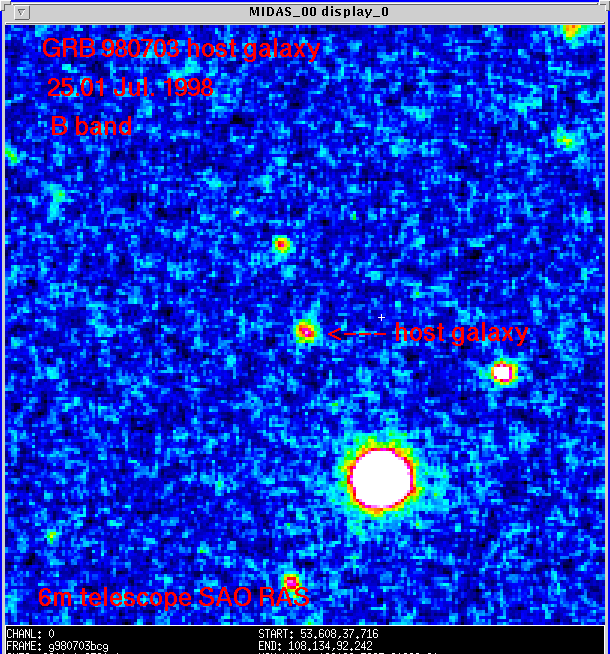
The broadband spectrum of the GRB 980703 host galaxy:
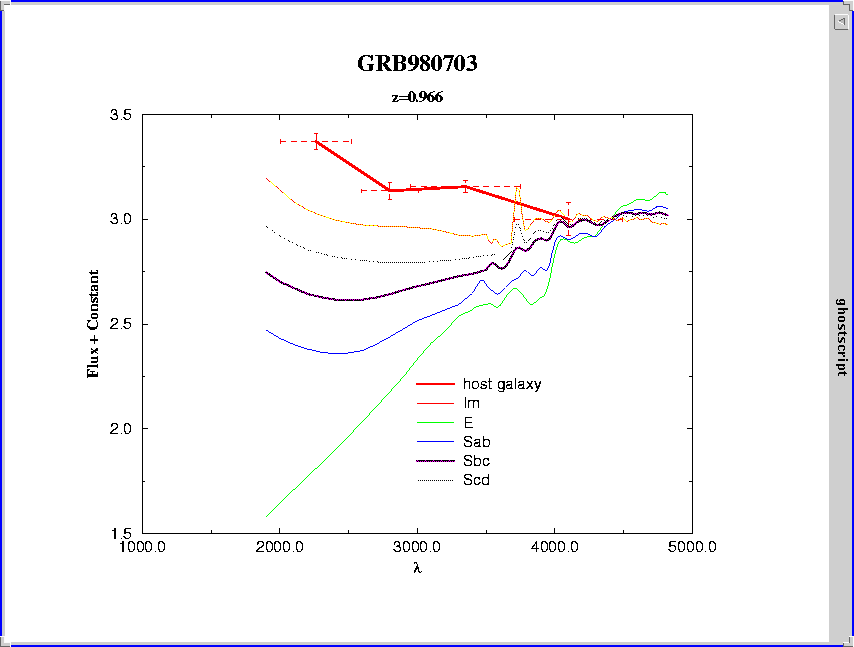
- GCN notice #152
G. B. Taylor, D. A. Frail, A. J. Beasley (NRAO) and S. R. Kulkarni
(CIT) report:
Using the Very Long Baseline Array (VLBA) we have detected the radio
source identified as the afterglow from GRB 980703 (GCN #128). During a
5 hour VLBA run on 1998 Aug 2 the radio source was found to have a
flux density of 580 +/- 60 microJy at 8.4 GHz. The source is
unresolved by these observations with a size less then 0.3 mas (size <
2 pc given the redshift of 0.9660 reported by Djorgovski et al. in GCN
#139). The position of GRB 980703 is R.A.=23h59m06.6661s,
Dec.=+08d35'07.09390" (equinox J2000) with an uncertainty of
approximately +/-0.0005" in each coordinate. This measurement is
consistent with that given by Frail et al. (GCN #141) with errors of
+/- 0.05".
Given the accuracy of the VLBA position for the afterglow (0.5 mas = 4
pc), it would be of interest to register the afterglow on subarcsecond
resolution observations of the host galaxy. Accurate absolute
astrometry at other wavebands are encouraged.
- 2 figures from Bloom et al (astro-ph/9808319):
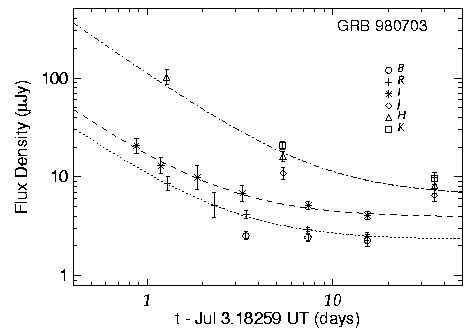
Optical and infrared light curve of the transient of GRB 980703. The fit to the
R-, I-, and H-band light curves are shown.
The first 4 I-band points are from Vreeswijk et al. (1998), and the first
H-band point from Henden et al. (1998).
The plotted fluxes have not been corrected for Galactic
extinction. We did not fit a model to the B-band light-curve since
the OT had faded away at B-band by the time of our first observation.
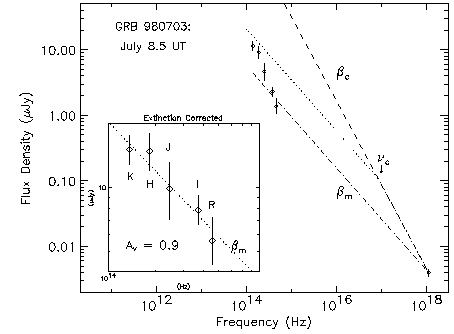
Inferred broad-band spectrum spectrum of the
transient afterglow of GRB 980703 on July 8.5. The fluxes plotted
above have been corrected for Galactic extinction.
We show the predicted spectra of the IR/optical/X-ray
if these frequencies were simultaneously in the synchrotron phase
(F_nu ~ nu^beta_m; dot-dashed line) or in the
synchrotron cooling regime (F_nu ~ nu^beta_c; dashed line).
- GCN notice #702
J. S. Bloom and S. R. Kulkarni report on behalf of the larger
Caltech-NRAO-CARA GRB Collaboration:
"The Hubble Space Telescope (HST) has recently observed the hosts of GRB
971214 and GRB 980703 with STIS as part of the Survey of the Host Galaxies
of Gamma-Ray Bursts (see S. Holland, B. Thomsen, H. Hjorth et al. GCN
#698). Here we present our data reduction of this public data and relate
the new STIS images to our previously obtained ground-based data and
space-based data.
GRB 980703:
This remains one of the brightest GRB host galaxies at R~22.8 and the
inferred GRB energy release is at the high end of the GRBs energy
distribution. The optical astrometry tie from Bloom et al. (1998,
ApJL 508, 21) revealed the GRB to be nearly coincident with its host
galaxy.
The GRB host was observed for a total of 5264 s with the STIS long-pass
filter (central wavelength ~ 7230 Ang and FWHM 2720 Ang) beginning 12.42
June 2000 UT. The galaxy is compact (though resolved) and has a low
ellipticity (~12%). The effective seeing of the drizzled image is 85
milliarcsec (FWHM) as measured from a bright star in the image and the
host has a FWHM diameter of 250 milliarcsec. This is consistent with our
report in Bloom et al. of an unresolved source in 0.5 arcsec seeing on
July 18 (when the host was thought to dominate the total light of the
source). At a redshift of z=0.966 (Djorgovski et al. ApJL 508, 17, 1998),
this implies a half-light radius of ~1.1 kpc (assuming H_0 = 65 km/s/Mpc,
Omega_0 = 0.3, Omega_lam = 0.7).
For photometric zero-pointing of the HST image, we compared two compact
objects in common to our deep Keck images from 18 July 1998 in V, R, I.
We find the host galaxy has R = 22.8 +/- 0.3 and I = 22.6 +/- 0.3. The
error is dominated by the uncertainty in the color correction. These
magnitudes are both within 1-sigma of those predicted for the host galaxy
in Bloom et al. from the light curve data. We conclude therefore there is
no evidence for the presence of a second light source (e.g. a supernova
component) in the early time light curve.
GRB 971214:
At z=3.418, this burst and its host remains the furthest of GRBs with
spectroscopically confirmed redshifts and also had an implied energy
release at the high end of the GRB energy distribution (Kulkarni et al.
1998, Nature, 393, 35). Using STIS imaging from 13 April 1998 we
previously reported (Odewahn et al. 1998 ApJL, 509, 5) the host as compact
core with an irregular envelope (half-light radius of 1.3 kpc).
Morphologically and in all other observed physical properties the host is
rather typical Lyman break galaxy at comparable redshifts. Further, we
found a small but significant offset of the GRB from the nucleus of the
galaxy.
The GRB host was observed for 8599s using STIS clear mode beginning 12.21
Jun 2000 UT. The final image has achieved approximately the same depth as
our previous STIS clear imaging. A visual comparison of the two epochs
reveals no obvious new or fading component. Our conclusions about the
nature of the host and its relation to the GRB remain unchanged from
Odewahn et al.
Our final reduced images can be obtained in .fits format at
http://astro.caltech.edu/~jsb/GRB/Host/
- 0807.4144from 25 Jul 2008
Starling: Examining the evidence for dust destruction in GRB 980703
Abstract: The effects that gamma-ray bursts have on their environments is an important
and outstanding issue. Dust destruction in particular has long been predicted
while observational evidence is difficult to obtain. We examine the evidence
for dust destruction by GRB 980703, in which various inconsistent measurements
of the host galaxy extinction have been made using the GRB afterglow emission.
We construct a spectral energy distribution from nIR to X-ray to measure the
extinction at early times and compare this with previous findings. We also
construct nIR/optical SEDs at intermediate epochs to examine a previously
reported decrease in extinction. The extinction is very high for a GRB host
galaxy. The earliest extinction measurement is likely to be lower than
previously estimated, and consistent with most later measurements. In a series
of SEDs we do not find any evidence of variable extinction. We therefore
conclude that there is no clear evidence of dust destruction in this case.
- 1609.04015 from 15 Sep 16
Daniel A. Perley et al.: Late-Time VLA Reobservations Rule Out ULIRG-Like Host Galaxies For Most Pre-Swift Long-Duration Gamma-Ray Bursts
We present new Jansky Very Large Array observations of five pre-Swift gamma-ray bursts for which an ultraluminous (SFR > 100 M_sun/yr) dusty
host galaxy had previously been inferred from late-time radio or submillimetre observations taken 1-3 years after the burst. In four of the
five cases we no longer detect any source at the host location to limits much fainter than the original observations, ruling out the existence
of an ultraluminous galaxy hosting any of these GRBs. We continue to detect a source at the position of GRB 980703, but it is much fainter than
it was a decade ago and the inferred radio star-formation rate (~80 M_sun) is relatively modest. The radio flattening at 200-1000 days observed
in the light curve of this GRB may have been caused by a decelerating counterjet oriented 180 degrees away from the viewer, although an
unjetted wind model can also explain the data. Our results eliminate all well-established pre-Swift ULIRG hosts, and all cases for which an
unobscured GRB was found in a galaxy dominated by heavily-obscured star-formation. When GRBs do occur in ULIRGs the afterglow is almost always
observed to be heavily obscured, consistent with the large dust opacities and high dust covering fractions characteristic of these systems.
![]() Previous IAU Circulars
Previous IAU Circulars 





